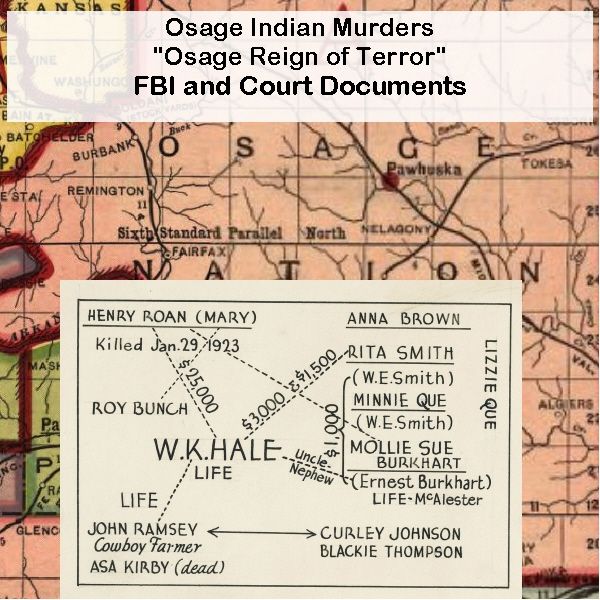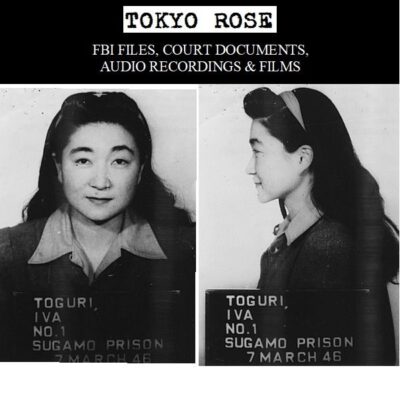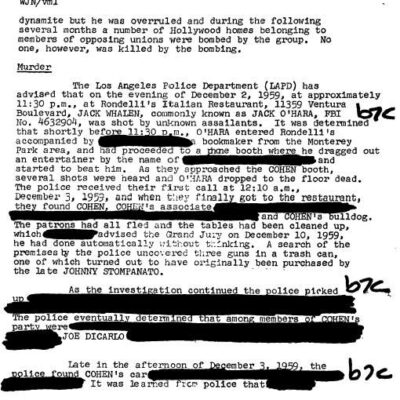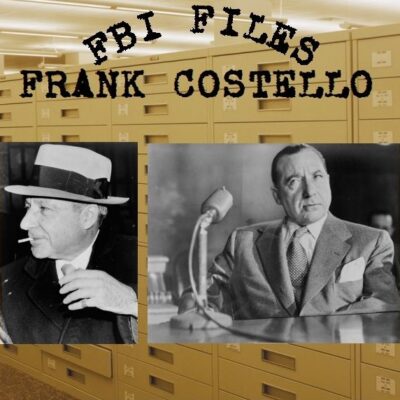
Osage Indian Murders “Osage Reign of Terror” FBI and Court Documents
$19.50
Description
Osage Murders: Oil, Greed, and Federal Investigation
Timeline of Main Events:
- Late 1800s: The Osage Nation purchases 1.5 million acres in northern Oklahoma, including resource rights, from the Cherokee Nation for $1 million after being pushed from their Kansas reservation by settlers. The federal government had previously paid the tribe $8.5 million for their Kansas reservation.
- Early 1920s: Oil is discovered on the Osage reservation, making members of the Osage Nation the wealthiest population group globally. By 1923, the average Osage household earns $65,000 annually from oil revenue, compared to $1,000 for the average white household in Oklahoma. In 1923 alone, the Osage Nation receives $27 million in oil revenue. This wealth also leads to the Osage becoming statistically the most murdered people in the United States.
- May 1921: The badly decomposed body of Anna Brown, a member of the Osage Nation, is found in a remote ravine in northern Oklahoma.
- July 1921 (approximately): Anna Brown’s mother, Lizzie Q, dies under suspicious circumstances.
- Around 1923: Anna Brown’s cousin, Henry Roan, is shot to death.
- March 1923: Anna Brown’s sister and brother-in-law are killed when their home is bombed. These are part of at least two dozen inexplicable deaths in the area, including Osage Indians and others like a well-known oilman.
- Around 1923: The Osage Tribal Council hires private detectives, who are unable to solve the murders.
- Around 1923: The Osage Tribal Council turns to the federal government for help. The Department of Interior writes to the Director of the Bureau of Investigation (BOI) requesting assistance in investigating the suspicious deaths. William J. Burns is the Director at this time.
- 1923 – 1932: The Bureau of Investigation (later the FBI in 1935) conducts an extensive investigation into the swindling and murder of Osage tribe members to gain control of their oil fields and insurance money.
- During the Investigation (1923-1929):FBI agents go undercover, posing as medicine men, cattlemen, a salesman, an insurance salesman, an oil prospector, and a herbal doctor to infiltrate the Osage reservation and gather evidence.
- Suspicion quickly focuses on William “King of Osage” Hale, a local cattleman known for his wealth and power obtained through bribery, intimidation, lies, and theft (including allegedly burning insured pastureland).
- Investigators discover Hale’s connection to Anna Brown’s family through his nephew, Ernest Burkhart, who is married to Anna’s sister. The investigators believe Hale orchestrated the murders to inherit the “head rights” of Anna and her family.
- Locals are hesitant to talk due to threats or payoffs from Hale and general distrust of outsiders. Hale also plants false leads to mislead investigators.
- Over time, agents gain the trust of the Osage people and build their case.
- Ernest Burkhart eventually talks, followed by confessions from others involved.
- Agents gather enough evidence to prove that Hale ordered the murders of Anna Brown and her family to acquire their oil rights, Henry Roan for insurance money, and others who threatened to expose him.
- 1926: The U.S. Supreme Court case United States v. Ramsey (271 U.S. 467) takes place. The Court rules that the federal government has the authority to prosecute crimes against Native Americans on reservation land that is still designated as Indian Country. This ruling is significant for the Osage murder cases.
- January 1929: William “King of Osage” Hale is convicted of the murders.
- 1929 (after conviction): Hale and other members of the Osage Indian Reservation involved in the murders are sentenced to life in prison.
Cast of Characters and Brief Bios:
- Anna Brown: A member of the Osage Nation whose badly decomposed body was found in May 1921. Her death was one of the first suspicious deaths that raised concerns.
- Lizzie Q: Anna Brown’s mother who died suspiciously two months after Anna’s death. Her death further fueled suspicions of foul play aimed at acquiring Osage wealth.
- Henry Roan: Anna Brown’s cousin who was shot to death approximately two years after Anna’s death. His murder is believed to have been orchestrated for insurance money.
- Anna Brown’s Sister (unnamed in the excerpts): Married to Ernest Burkhart. She and her husband were killed in a bombing in March 1923. Her death was part of the scheme to consolidate head rights.
- Anna Brown’s Brother-in-law (unnamed in the excerpts): Married to Anna Brown’s sister. He was killed along with his wife in the March 1923 bombing.
- William “King of Osage” Hale: A local white cattleman in Osage County, known for his wealth and influence. He is identified as the central figure behind the murders of the Osage people, motivated by greed to control their oil wealth and insurance money. He was eventually convicted and sentenced to life in prison.
- Ernest Burkhart: William Hale’s nephew who was married to Anna Brown’s sister. He is described as weak-willed and was part of Hale’s scheme. He eventually confessed to his involvement.
- William J. Burns: The Director of the Bureau of Investigation (BOI) when the Department of Interior requested federal assistance in the Osage murder investigation.
- FBI Agents (unnamed individually in the excerpts): Agents of the Bureau of Investigation who went undercover on the Osage reservation, posing in various roles to gain the trust of the community and gather evidence against those responsible for the murders. They played a crucial role in solving the case.
- Osage Tribal Council: The governing body of the Osage Nation. They initially hired private detectives and later appealed to the federal government for help in investigating the murders.
- Dennis McAuliffe Jr.: Author of the book “Bloodland: A Family Story of Oil, Greed and Murder on the Osage Reservation.” His work provides insights into William Hale’s methods, including allegedly burning insured pastureland for profit.
Osage Indian Murders “Osage Reign of Terror” FBI and Court Documents
3,601 pages of material.
In the 1920’s oil made the members of the Osage Nation the richest population group in the World. In 1923, in Oklahoma the average White household earned $1,000 a year, with distributions from oil revenue the average Osage household earned $65,000. In 1923, the Osage Nation received $27 million of revenue from oil drilled on its reservation. It also led to them becoming statistically the most murdered people in the United States. The Osage bought 1.5 million acres in northern Oklahoma, including the rights to its resources, for $1 million from the Cherokee Nation in the late 1800s after settlers pushed them from their reservation in Kansas. The federal government paid the tribe $8.5 million for its Kansas reservation.
FBI FILES
3,332 pages of files copied from FBI Headquarters in Washington, D.C., covering the Osage Indian Murders. Files contain approximately 2,800 pages of narrative material. Files date from 1923 to 1932.
The Bureau investigated this case involving the swindling and murder of members of the Osage Indian tribe in Oklahoma for the rights to their oil fields. Between 1921-1923 members of the Osage Indian Reservation died under suspicious circumstances. The FBI became involved after the Department of Interior wrote to Director William J. Burns requesting assistance in investigating these deaths. William “King of Osage” Hale was suspected of being involved in the deaths. Posing as medicine men, cattlemen and a salesman, FBI agents infiltrated the reservation and eventually solved several of the murders. Hale and other members of the Osage Indian Reservation were convicted of the murders and sentenced to life in prison. The murders were committed in an attempt to collect insurance money and gain control of valuable oil properties owned by the deceased Osage Indians.
COURT FILES
254 pages of U.S. District Court for the Western District of Oklahoma court files from the criminal cases arising from the “Osage Reign of Terror,” and the decision in United States v. Ramsey, 271 U.S. 467 (1926). United States v. Ramsey was a U.S. Supreme Court case brought by a defend in the Osage case, in which the Court held that the government had the authority to prosecute crimes against Native Americans (Indians) on reservation land that was still designated Indian Country by federal law.
OTHER MATERIAL
Other material includes FBI photos and the Osage Nation’s account of the facts of the “Osage Reign of Terror.”
BACKGROUND
The Osage became wealthy by earning royalties from oil sales through their federally mandated “head rights.”
In May 1921, the badly decomposed body of Anna Brown, a member of the Osage Nation, was found in a remote ravine in northern Oklahoma. Two months later, Anna’s mother, Lizzie Q, suspiciously died. Two years later, her cousin Henry Roan was shot to death. Then, in March 1923, Anna’s sister and brother-in-law were killed when their home was bombed. One by one, at least two dozen people in the area inexplicably turned up dead. Not just Osage Indians, but a well-known oilman and others.
The Osage Tribal Council hired private detectives who turned up nothing. The Osage Tribal Council turned to the federal government, and Bureau of Investigation (in 1935, the Bureau of Investigation became the Federal Bureau of Investigation) agents were detailed to the case.
Suspicion quickly turned to local cattleman William Hale the so-called “King of the Osage Hills.” Hale had bribed, intimidated, lied, and stolen his way to wealth and power. According to author of Bloodland: A Family Story of Oil, Greed and Murder on the Osage Reservation, Dennis McAuliffe Jr., Hale earned much of his fortune by insuring his Osage pastureland for $1 an acre and then ordering his ranch hands to torch 30,000 acres one night.
Hale’s connection to Anna Brown’s family was clear. His weak-willed nephew, Ernest Burkhart, was married to Anna’s sister. If Anna, her mother, and two sisters died, in that order, all of the “head rights” would pass to the nephew and Hale could take control. Half a million dollars a year or more.
Bureau investigators found that locals weren’t talking. Hale had threatened or paid off many of them; the rest had grown distrustful of outsiders. Hale also planted false leads that sent agents scurrying across the southwest.
Agents found it necessary to go undercover as an insurance salesman, cattle buyer, oil prospector, and a herbal doctor to turn up evidence. Over time, they gained the trust of the Osage and built a case. Finally, the nephew talked. Then others confessed. The agents were able to prove that Hale ordered the murders of Anna and her family to inherit their oil rights, cousin Roan for the insurance and others who had threatened to expose him. In January 1929, Hale was convicted.










